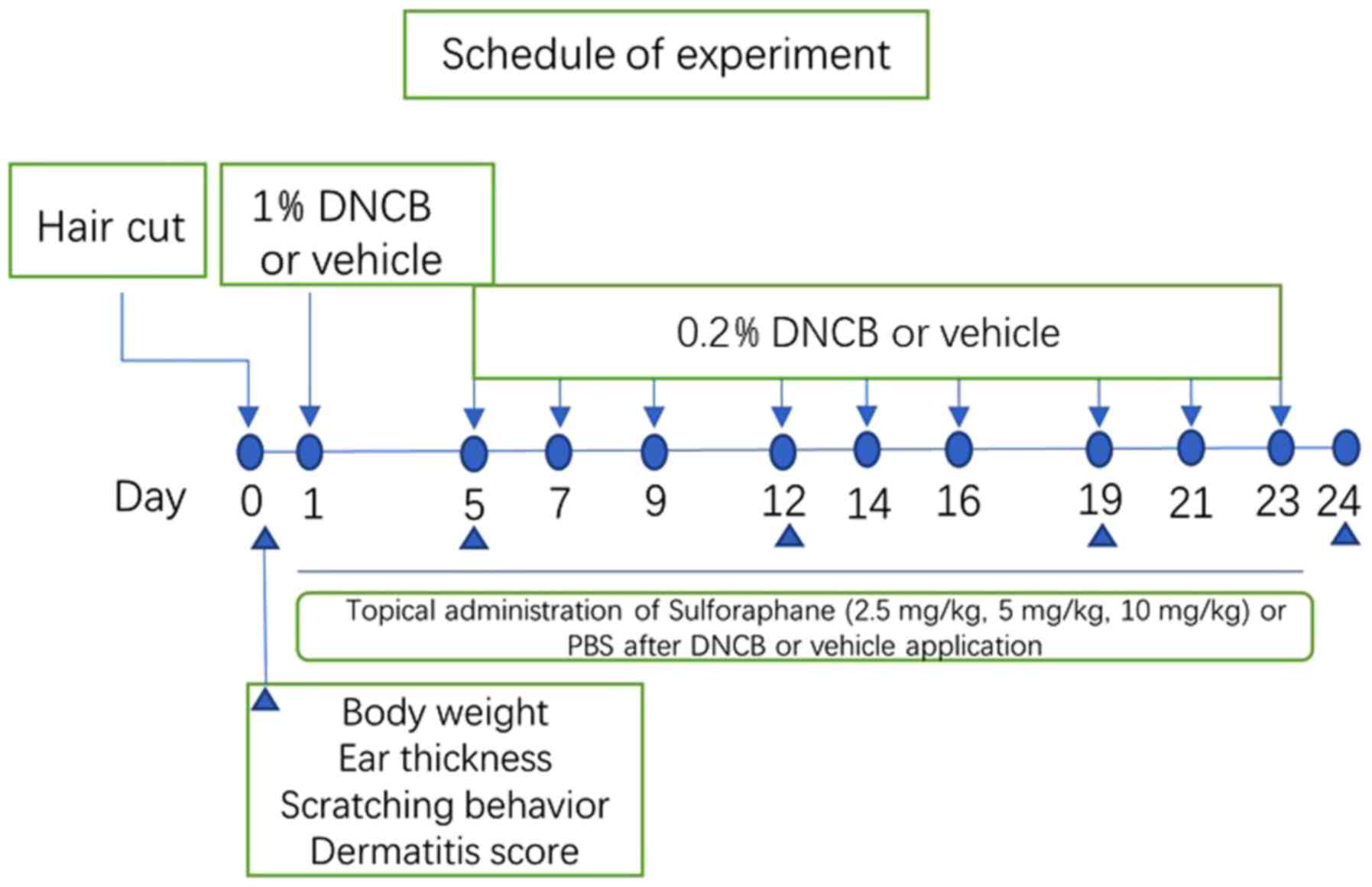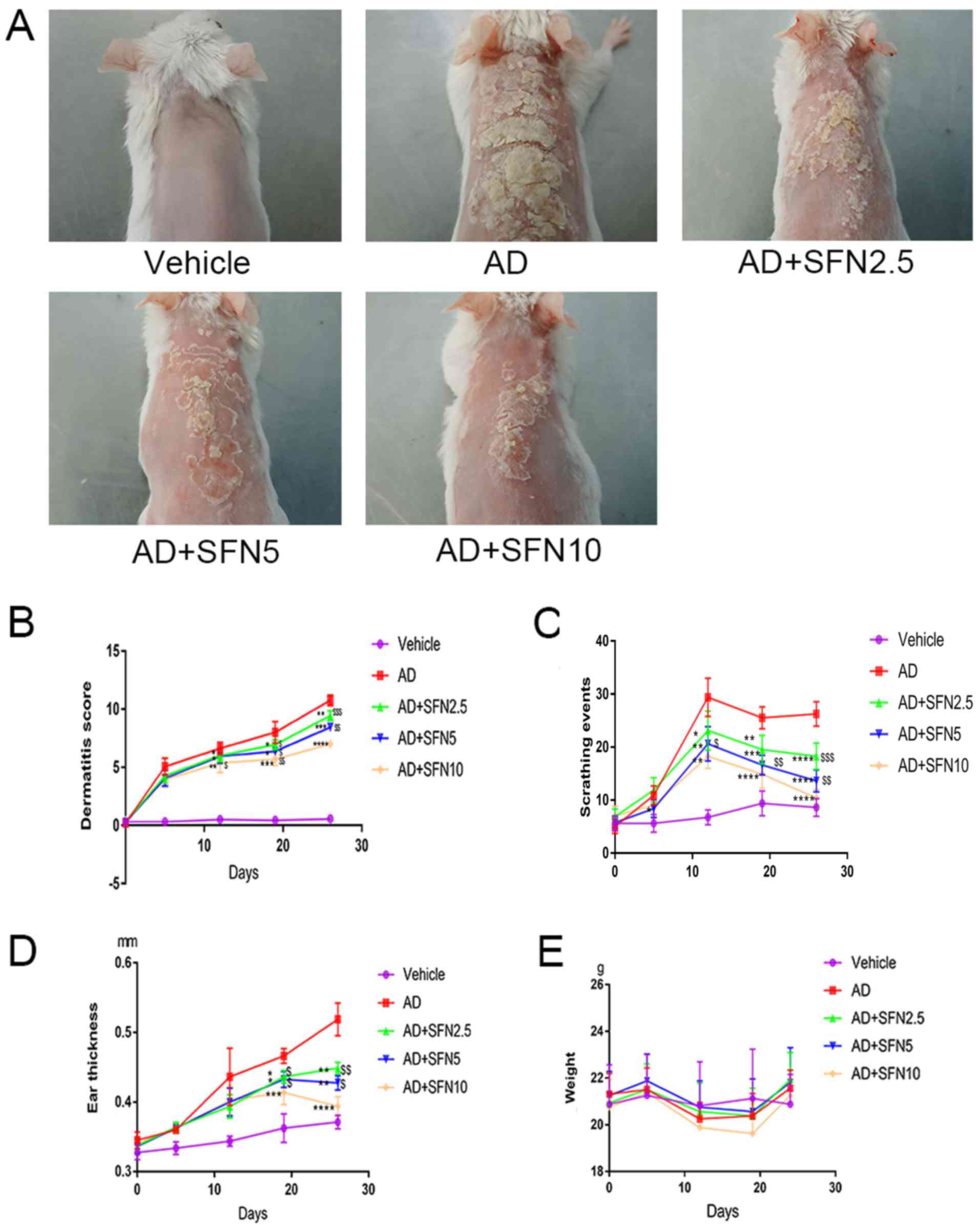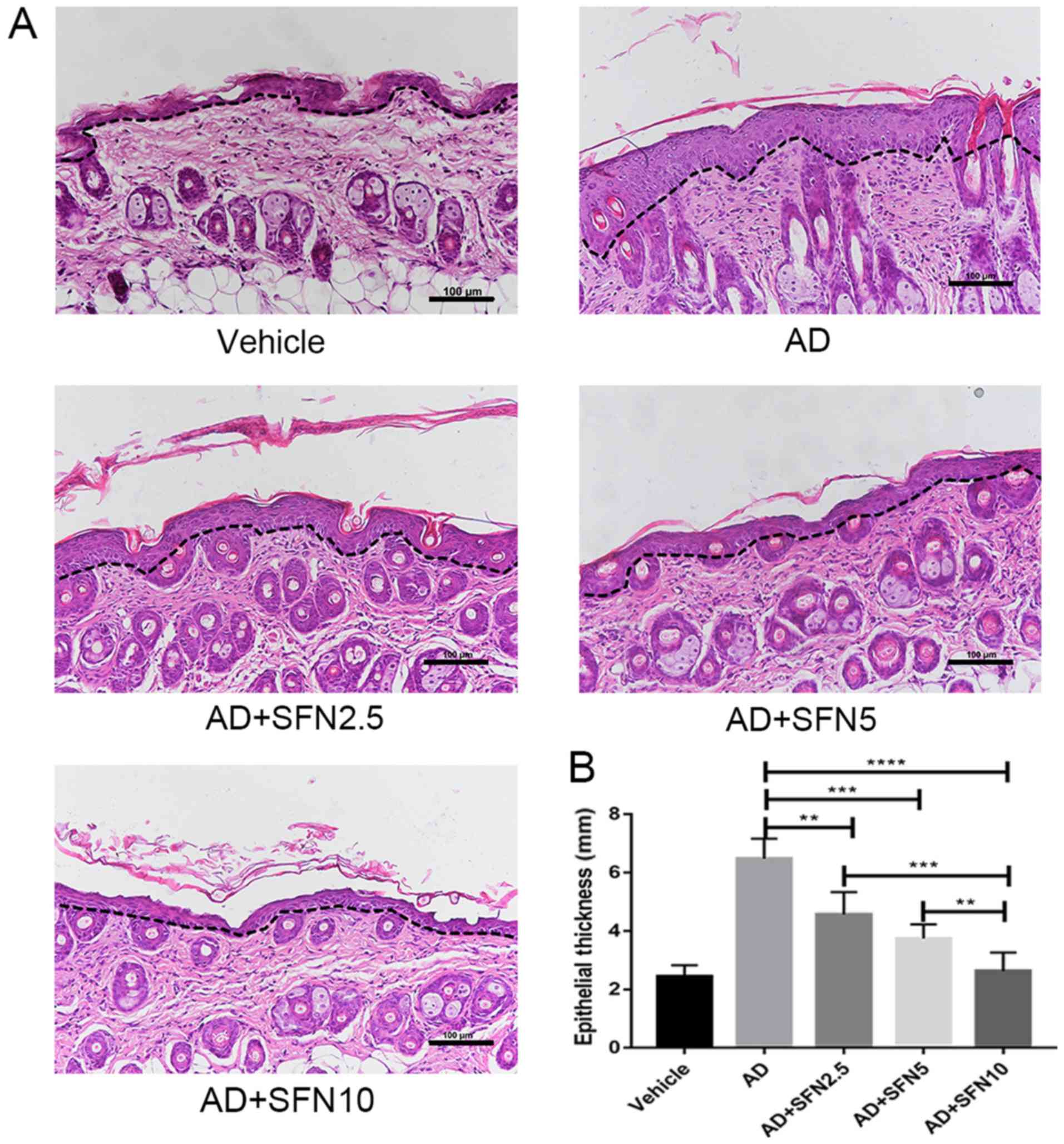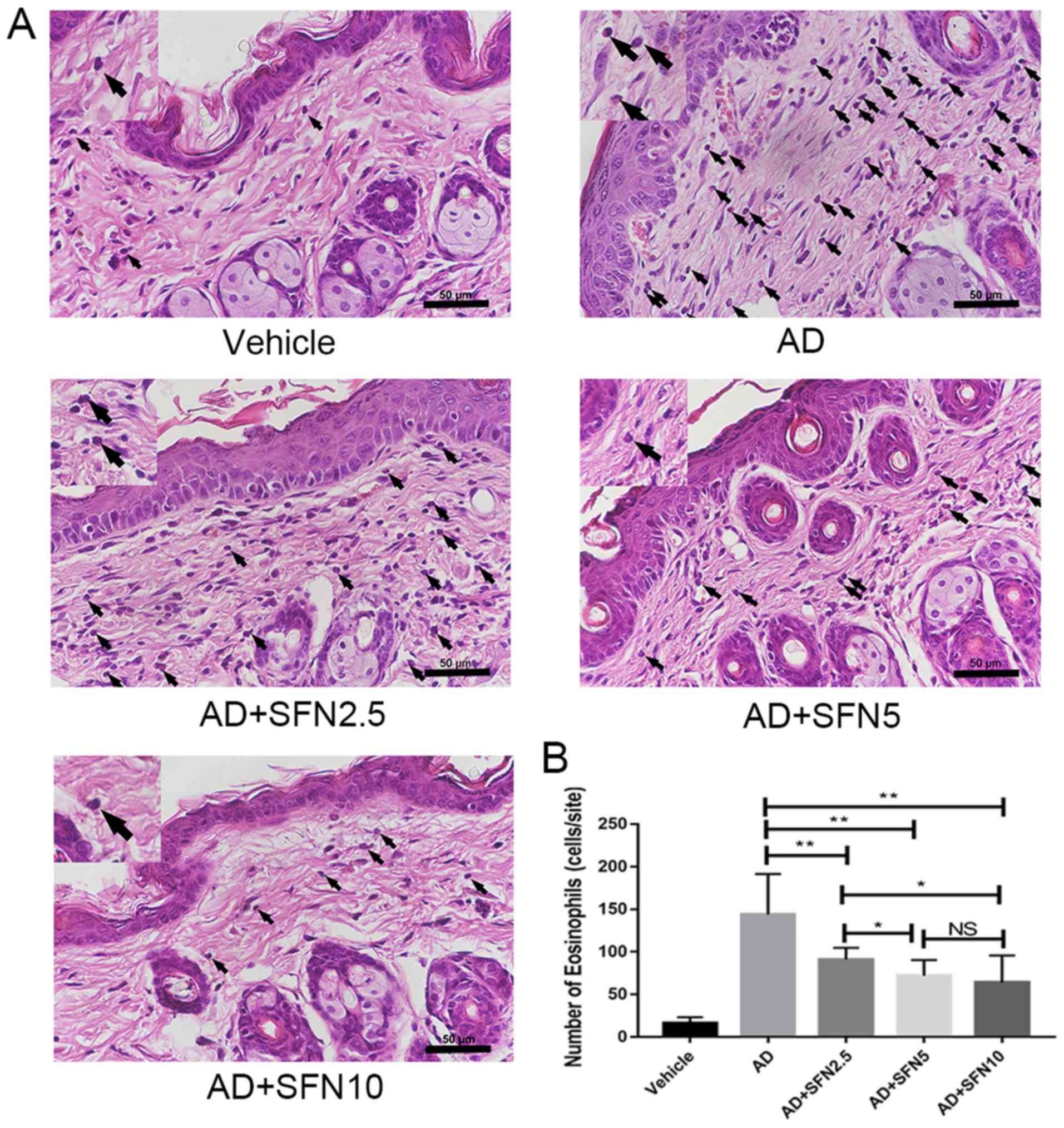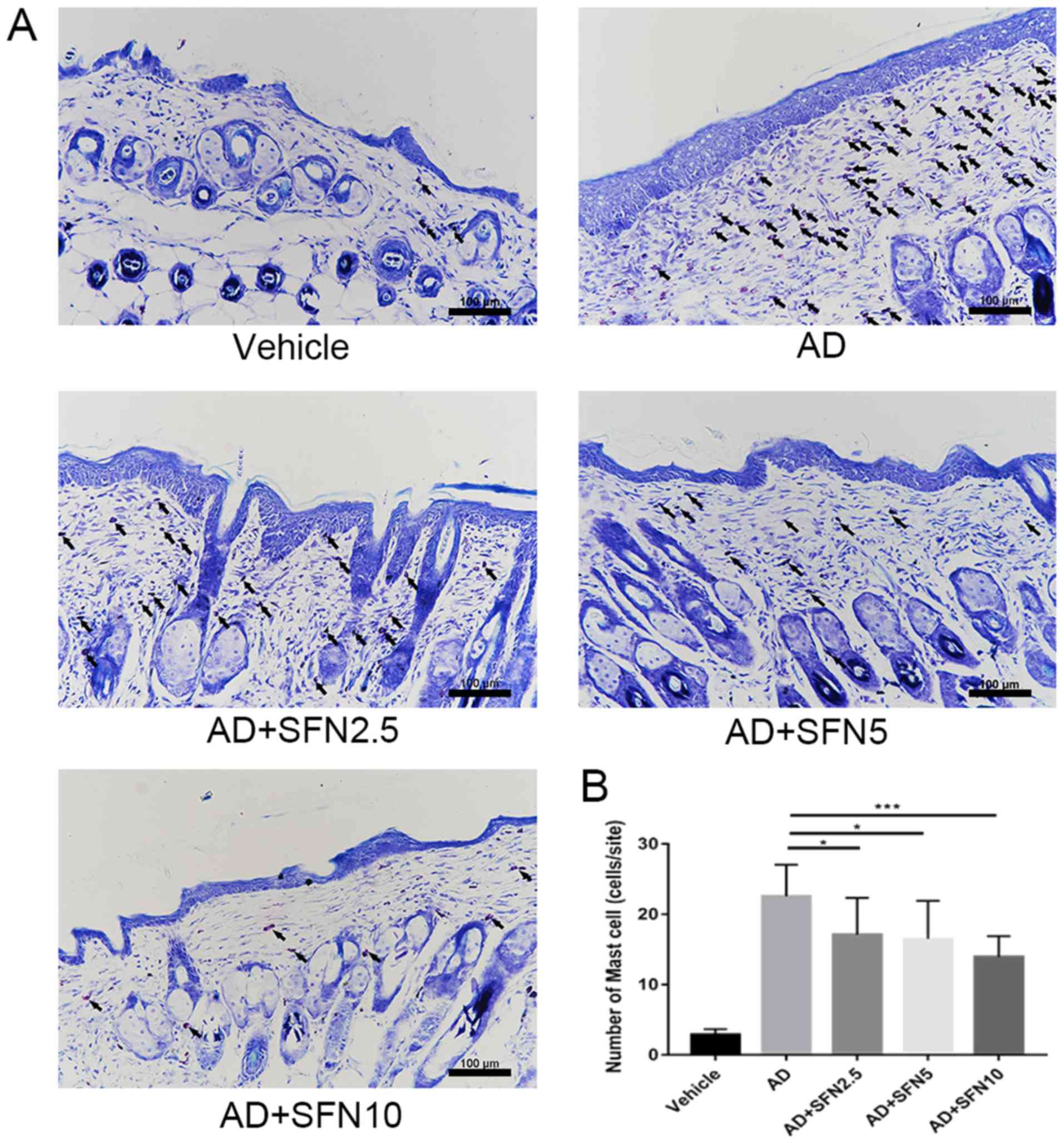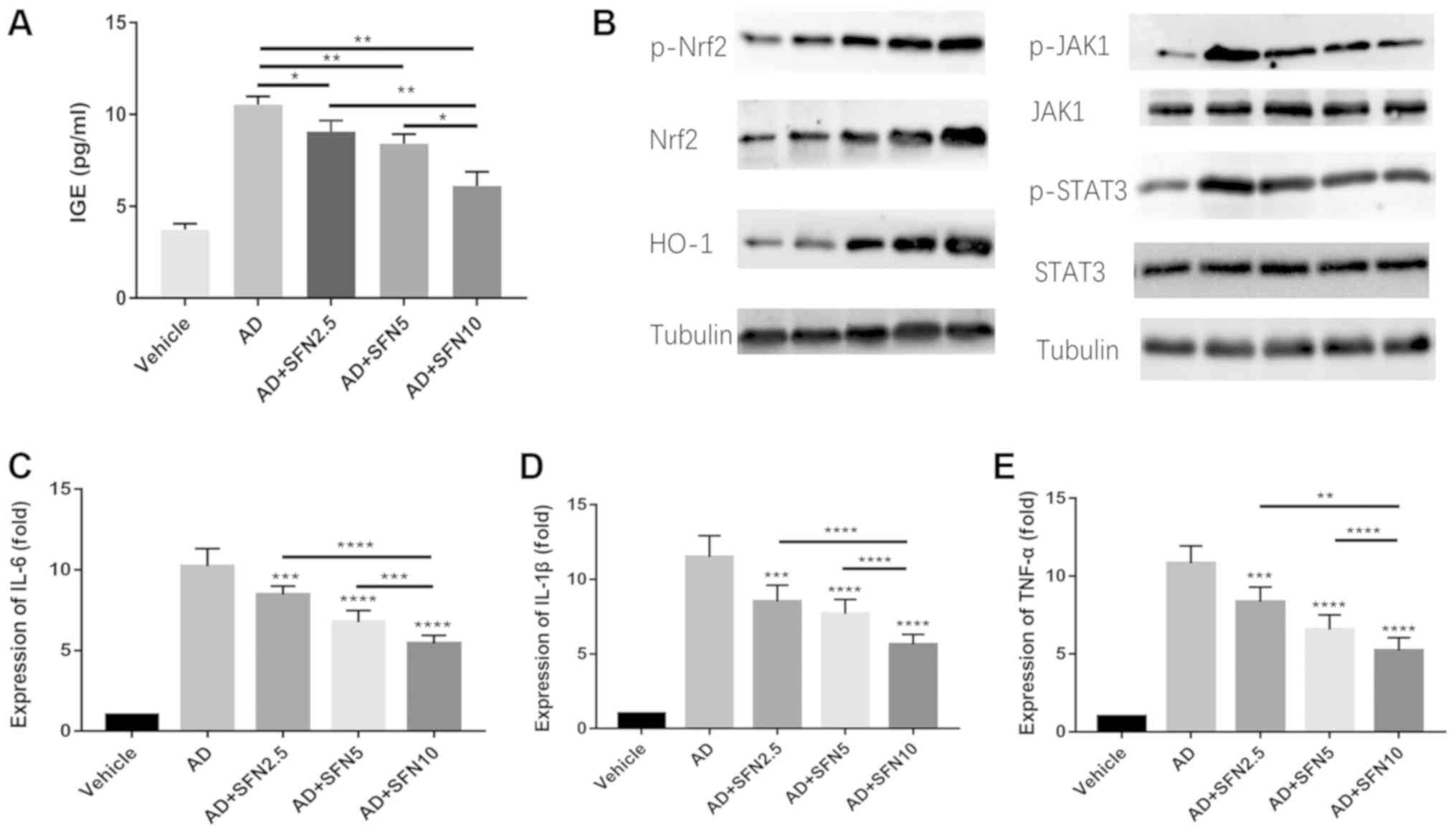|
1
|
Bieber T: Atopic dermatitis. N Engl J Med.
358:1483–1494. 2008. View Article : Google Scholar : PubMed/NCBI
|
|
2
|
Weidinger S and Novak N: Atopic
dermatitis. Lancet. 387:1109–1122. 2016. View Article : Google Scholar : PubMed/NCBI
|
|
3
|
Werfel T, Schwerk N, Hansen G and Kapp A:
The diagnosis and graded therapy of atopic dermatitis. Dtsch
Arztebl Int. 111:509–520. 2014.PubMed/NCBI
|
|
4
|
Gęgotek A and Skrzydlewska E: The role of
transcription factor Nrf2 in skin cells metabolism. Arch Dermatol
Res. 307:385–396. 2015. View Article : Google Scholar : PubMed/NCBI
|
|
5
|
Ji H and Li XK: Oxidative stress in atopic
dermatitis. Oxid Med Cell Longev. 2016:27214692016. View Article : Google Scholar : PubMed/NCBI
|
|
6
|
Rojo de la Vega M, Krajisnik A, Zhang DD
and Wondrak GT: Targeting NRF2 for improved skin barrier function
and photoprotection: Focus on the achiote-derived apocarotenoid
bixin. Nutrients. 9:E13712017. View Article : Google Scholar : PubMed/NCBI
|
|
7
|
Gruber F, Ornelas CM, Karner S, Narzt MS,
Nagelreiter IM, Gschwandtner M, Bochkov V and Tschachler E: Nrf2
deficiency causes lipid oxidation, inflammation and matrix-protease
expression in DHA supplemented and UVA irradiated skin fibroblasts.
Free Radic Biol Med. 88:439–451. 2015. View Article : Google Scholar : PubMed/NCBI
|
|
8
|
Guerrero-Beltrán CE, Calderón-Oliver M,
Pedraza-Chaverri J and Chirino YI: Protective effect of
sulforaphane against oxidative stress: Recent advances. Exp Toxicol
Pathol. 64:503–508. 2012. View Article : Google Scholar : PubMed/NCBI
|
|
9
|
Mathew ST, Bergström P and Hammarsten O:
Repeated Nrf2 stimulation using sulforaphane protects fibroblasts
from ionizing radiation. Toxicol Appl Pharmacol. 276:188–194. 2014.
View Article : Google Scholar : PubMed/NCBI
|
|
10
|
Kumar KJ, Yang HL, Tsai YC, Hung PC, Chang
SH, Lo HW, Shen PC, Chen SC, Wang HM, Wang SY, et al: Lucidone
protects human skin keratinocytes against free radical-induced
oxidative damage and inflammation through the up-regulation of
HO-1/Nrf2 antioxidant genes and down-regulation of NF-κB signaling
pathway. Food Chem Toxicol. 59:55–66. 2013. View Article : Google Scholar : PubMed/NCBI
|
|
11
|
Furue M, Chiba T, Tsuji G, Ulzii D,
Kido-Nakahara M, Nakahara T and Kadono T: Atopic dermatitis: Immune
deviation, barrier dysfunction, IgE autoreactivity and new
therapies. Allergol Int. 66:398–403. 2017. View Article : Google Scholar : PubMed/NCBI
|
|
12
|
Kiiski V, Karlsson O, Remitz A and Reitamo
S: High serum total IgE predicts poor long-term outcome in atopic
dermatitis. Acta Derm Venereol. 95:943–947. 2015. View Article : Google Scholar : PubMed/NCBI
|
|
13
|
Lucae S, Schmid-Grendelmeier P, Wüthrich
B, Kraft D, Valenta R and Linhart B: IgE responses to exogenous and
endogenous allergens in atopic dermatitis patients under long-term
systemic cyclosporine A treatment. Allergy. 71:115–118. 2016.
View Article : Google Scholar : PubMed/NCBI
|
|
14
|
Altrichter S, Kriehuber E, Moser J,
Valenta R, Kopp T and Stingl G: Serum IgE autoantibodies target
keratinocytes in patients with atopic dermatitis. J Invest
Dermatol. 128:2232–2239. 2008. View Article : Google Scholar : PubMed/NCBI
|
|
15
|
Liu FT, Goodarzi H and Chen HY: IgE, mast
cells, and eosinophils in atopic dermatitis. Clin Rev Allergy
Immunol. 41:298–310. 2011. View Article : Google Scholar : PubMed/NCBI
|
|
16
|
Elovic A, Wong DT, Weller PF, Matossian K
and Galli SJ: Expression of transforming growth factors-alpha and
beta 1 messenger RNA and product by eosinophils in nasal polyps. J
Allergy Clin Immunol. 93:864–869. 1994. View Article : Google Scholar : PubMed/NCBI
|
|
17
|
Kato A, Chustz RT, Ogasawara T, Kulka M,
Saito H, Schleimer RP and Matsumoto K: Dexamethasone and FK506
inhibit expression of distinct subsets of chemokines in human mast
cells. J Immunol. 182:7233–7243. 2009. View Article : Google Scholar : PubMed/NCBI
|
|
18
|
Zhang JC, Yao W, Dong C, Yang C, Ren Q, Ma
M, Han M, Wu J, Ushida Y, Suganuma H and Hashimoto K: Prophylactic
effects of sulforaphane on depression-like behavior and dendritic
changes in mice after inflammation. J Nutr Biochem. 39:134–144.
2017. View Article : Google Scholar : PubMed/NCBI
|
|
19
|
Yan B, Ma Z, Shi S, Hu Y, Ma T, Rong G and
Yang J: Sulforaphane prevents bleomycin-induced pulmonary fibrosis
in mice by inhibiting oxidative stress via nuclear factor erythroid
2-related factor-2 activation. Mol Med Rep. 15:4005–4014. 2017.
View Article : Google Scholar : PubMed/NCBI
|
|
20
|
O'Connor JC, Lawson MA, André C, Moreau M,
Lestage J, Castanon N, Kelley KW and Dantzer R:
Lipopolysaccharide-induced depressive-like behavior is mediated by
indoleamine 2,3-dioxygenase activation in mice. Mol Psychiatry.
14:511–522. 2009. View Article : Google Scholar : PubMed/NCBI
|
|
21
|
Peng G, Mu Z, Cui L, Liu P, Wang Y, Wu W
and Han X: Anti-IL-33 antibody has a therapeutic effect in an
atopic dermatitis murine model induced by 2,
4-dinitrochlorobenzene. Inflammation. 41:154–163. 2018. View Article : Google Scholar : PubMed/NCBI
|
|
22
|
Livak KJ and Schmittgen TD: Analysis of
relative gene expression data using real-time quantitative PCR and
the 2(-Delta Delta C(T)) method. Methods. 25:402–408. 2001.
View Article : Google Scholar : PubMed/NCBI
|
|
23
|
David Boothe W, Tarbox JA and Tarbox MB:
Atopic dermatitis: Pathophysiology. Adv Exp Med Biol. 1027:21–37.
2017. View Article : Google Scholar : PubMed/NCBI
|
|
24
|
Briganti S and Picardo M: Antioxidant
activity, lipid peroxidation and skin diseases. What's new. J Eur
Acad Dermatol Venereol. 17:663–669. 2010. View Article : Google Scholar
|
|
25
|
Yang L, Palliyaguru DL and Kensler TW:
Frugal chemoprevention: Targeting Nrf2 with foods rich in
sulforaphane. Semin Oncol. 43:146–153. 2016. View Article : Google Scholar : PubMed/NCBI
|
|
26
|
Ruiz S, Pergola PE, Zager RA and Vaziri
ND: Targeting the transcription factor Nrf2 to ameliorate oxidative
stress and inflammation in chronic kidney disease. Kidney Int.
83:1029–1041. 2013. View Article : Google Scholar : PubMed/NCBI
|
|
27
|
Lawal AO: Air particulate matter induced
oxidative stress and inflammation in cardiovascular disease and
atherosclerosis: The role of Nrf2 and AhR-mediated pathways.
Toxicol Lett. 270:88–95. 2017. View Article : Google Scholar : PubMed/NCBI
|
|
28
|
Prasad KN: Simultaneous activation of Nrf2
and elevation of antioxidant compounds for reducing oxidative
stress and chronic inflammation in human Alzheimer's disease. Mech
Ageing Dev. 153:41–47. 2016. View Article : Google Scholar : PubMed/NCBI
|
|
29
|
Schäfer M, Farwanah H, Willrodt AH,
Huebner AJ, Sandhoff K, Roop D, Hohl D, Bloch W and Werner S: Nrf2
links epidermal barrier function with antioxidant defense. EMBO Mol
Med. 4:364–379. 2012. View Article : Google Scholar : PubMed/NCBI
|
|
30
|
Choi JH, Jin SW, Han EH, Park BH, Kim HG,
Khanal T, Hwang YP, Do MT, Lee HS, Chung YC, et al: Platycodon
grandiflorum root-derived saponins attenuate atopic dermatitis-like
skin lesions via suppression of NF-κB and STAT1 and activation of
Nrf2/ARE-mediated heme oxygenase-1. Phytomedicine. 21:1053–1061.
2014. View Article : Google Scholar : PubMed/NCBI
|
|
31
|
Saw CL, Huang MT, Liu Y, Khor TO, Conney
AH and Kong AN: Impact of Nrf2 on UVB-induced skin
inflammation/photoprotection and photoprotective effect of
sulforaphane. Mol Carcinog. 50:479–486. 2011. View Article : Google Scholar : PubMed/NCBI
|
|
32
|
Chaiprasongsuk A, Lohakul J, Soontrapa K,
Sampattavanich S, Akarasereenont P and Panich U: Activation of Nrf2
reduces UVA-mediated MMP-1 upregulation via MAPK/AP-1 signaling
cascades: The photoprotective effects of sulforaphane and
hispidulin. J Pharmacol Exp Ther. 360:388–398. 2017. View Article : Google Scholar : PubMed/NCBI
|
|
33
|
Migdal C, Botton J, El Ali Z, Azoury ME,
Guldemann J, Giménez-Arnau E, Lepoittevin JP, Kerdine-Römer S and
Pallardy M: Reactivity of chemical sensitizers toward amino acids
in cellulo plays a role in the activation of the Nrf2-ARE pathway
in human monocyte dendritic cells and the THP-1 cell line. Toxicol
Sci. 133:259–274. 2013. View Article : Google Scholar : PubMed/NCBI
|
|
34
|
Emter R, van der Veen JW, Adamson G,
Ezendam J, van Loveren H and Natsch A: Gene expression changes
induced by skin sensitizers in the KeratinoSens™ cell line:
Discriminating Nrf2-dependent and Nrf2-independent events. Toxicol
In Vitro. 27:2225–2232. 2013. View Article : Google Scholar : PubMed/NCBI
|
|
35
|
Welsch K, Holstein J, Laurence A and
Ghoreschi K: Targeting JAK/STAT signalling in inflammatory skin
diseases with small molecule inhibitors. Eur J Immunol.
47:1096–1107. 2017. View Article : Google Scholar : PubMed/NCBI
|
|
36
|
Jin W, Huang W, Chen L, Jin M, Wang Q, Gao
Z and Jin Z: Topical application of JAK1/JAK2 inhibitor momelotinib
exhibits significant anti-inflammatory responses in DNCB-induced
atopic dermatitis model mice. Int J Mol Sci. 19:E39732018.
View Article : Google Scholar : PubMed/NCBI
|
|
37
|
Abe Y and Tanaka N: The Hedgehog signaling
networks in lung cancer: The mechanisms and roles in tumor
progression and implications for cancer therapy. Biomed Res Int.
2016:79692862016. View Article : Google Scholar : PubMed/NCBI
|
|
38
|
Chu J, Wang X, Bi H, Li L, Ren M and Wang
J: Dihydromyricetin relieves rheumatoid arthritis symptoms and
suppresses expression of pro-inflammatory cytokines via the
activation of Nrf2 pathway in rheumatoid arthritis model. Int
Immunopharmacol. 59:174–180. 2018. View Article : Google Scholar : PubMed/NCBI
|
|
39
|
Roy R, Dagher A, Butterfield C and Moses
MA: ADAM12 is a novel regulator of tumor angiogenesis via STAT3
signaling. Mol Cancer Res. 15:1608–1622. 2017. View Article : Google Scholar : PubMed/NCBI
|
|
40
|
Choi JK, Jang YH, Lee S, Lee SR, Choi YA,
Jin M, Choi JH, Park JH, Park PH, Choi H, et al: Chrysin attenuates
atopic dermatitis by suppressing inflammation of keratinocytes.
Food Chem Toxicol. 110:142–150. 2017. View Article : Google Scholar : PubMed/NCBI
|
|
41
|
Pastore S, Giustizieri ML, Mascia F,
Giannetti A, Kaushansky K and Girolomoni G: Dysregulated activation
of activator protein 1 in keratinocytes of atopic dermatitis
patients with enhanced expression of granulocyte/macrophage-colony
stimulating factor. J Invest Dermatol. 115:1134–1143. 2000.
View Article : Google Scholar : PubMed/NCBI
|
|
42
|
Mashiko S, Bouguermouh S, Rubio M, Baba N,
Bissonnette R and Sarfati M: Human mast cells are major IL-22
producers in patients with psoriasis and atopic dermatitis. J
Allergy Clin Immunol. 136:351–359.e1. 2015. View Article : Google Scholar : PubMed/NCBI
|
|
43
|
Mu Z, Zhao Y, Liu X, Chang C and Zhang J:
Molecular biology of atopic dermatitis. Clin Rev Allergy Immunol.
47:193–218. 2014. View Article : Google Scholar : PubMed/NCBI
|
|
44
|
Matsushima M, Takagi K, Ogawa M, Hirose E,
Ota Y, Abe F, Baba K, Hasegawa T, Hasegawa Y and Kawabe T: Heme
oxygenase-1 mediates the anti-allergic actions of quercetin in
rodent mast cells. Inflammation Res. 58:705–715. 2009. View Article : Google Scholar
|
|
45
|
Ma YY, Yang MQ, Wang CF, Ding J and Li JY:
Inhibiting mast cell degranulation by HO-1 affects dendritic cell
maturation in vitro. Inflamm Res. 63:527–537. 2014. View Article : Google Scholar : PubMed/NCBI
|
|
46
|
Zink A, Gensbaur A, Zirbs M, Seifert F,
Suarez IL, Mourantchanian V, Weidinger S, Mempel M, Ring J and
Ollert M: Targeting IgE in severe atopic dermatitis with a
combination of immunoadsorption and omalizumab. Acta Derm Venereol.
96:72–76. 2016. View Article : Google Scholar : PubMed/NCBI
|
|
47
|
Park G, Oh DS, Lee MG, Lee CE and Kim YU:
6-Shogaol, an active compound of ginger, alleviates allergic
dermatitis-like skin lesions via cytokine inhibition by activating
the Nrf2 pathway. Toxicol Appl Pharmacol. 310:51–59. 2016.
View Article : Google Scholar : PubMed/NCBI
|
|
48
|
Kiehl P, Falkenberg K, Vogelbruch M and
Kapp A: Tissue eosinophilia in acute and chronic atopic dermatitis:
A morphometric approach using quantitative image analysis of
immunostaining. Br J Dermatol. 145:720–729. 2001. View Article : Google Scholar : PubMed/NCBI
|
|
49
|
Ajith Y, Dimri U, Gopalakrishnan A,
Madhesh E, Jhambh R, Joshi V and Devi G: Th1/Th2 immune responses
and oxidative stress in caprine flea allergy dermatitis. Parasite
Immunol. 39:2017. View Article : Google Scholar : PubMed/NCBI
|
|
50
|
Werfel T, Allam JP, Biedermann T, Eyerich
K, Gilles S, Guttman-Yassky E, Hoetzenecker W, Knol E, Simon HU,
Wollenberg A, et al: Cellular and molecular immunologic mechanisms
in patients with atopic dermatitis. J Allergy Clin Immunol.
138:336–349. 2016. View Article : Google Scholar : PubMed/NCBI
|















